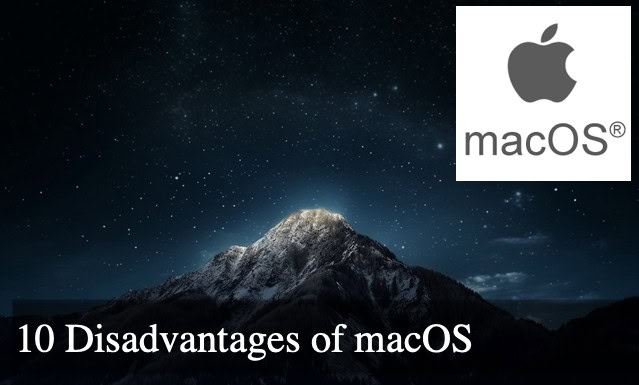Top 10 Cons & Disadvantages of macOS

The macOS operating system, developed by Apple Inc., has long been celebrated for its sleek interface, seamless integration with Apple’s ecosystem, and robust security features. However, despite its many strengths, macOS is not without its shortcomings. Users from various backgrounds, including those accustomed to other operating systems like Windows or Linux, often point out several drawbacks that affect their user experience and productivity. Understanding these disadvantages is essential for potential users to make an informed decision regarding their operating system choice.
One of the primary critiques of macOS is its compatibility limitations with software applications, particularly those not developed within the Apple ecosystem. This can pose significant challenges for professionals relying on specific software for daily operations. Additionally, macOS operates on a closed-source framework, which restricts user customization and control compared to open-source alternatives. Moreover, the hardware dependency means that macOS runs exclusively on Apple devices, often priced higher than their PC counterparts. This article aims to explore these issues in depth, providing a comprehensive overview of the top ten disadvantages of using macOS.
The Top 10 Problems or Drawbacks of macOS
While macOS is renowned for its design and user-friendly features, several disadvantages can impact users differently, depending on their needs and tech preferences. This section lists the top ten cons of macOS, including hardware compatibility, cost, and software availability. Each disadvantage will be detailed further, shedding light on how they collectively contribute to a critical perspective on this otherwise highly acclaimed operating system. These insights aim to equip potential users with a balanced view, ensuring they know the benefits and limitations of adopting macOS as their primary operating system.
Disadvantage #1: Limited Software Compatibility
One of the most significant challenges macOS users face is its limited software compatibility. This issue primarily affects professionals who require specialized software often optimized for Windows.
- Limited availability of third-party software: Many industry-standard software tools are developed with Windows in mind, leading to fewer versions or delayed releases for macOS.
- Difficulty in cross-platform operations: Businesses that operate in a mixed-device environment may find it difficult to maintain smooth interoperability between macOS and other operating systems.
- Higher costs for compatible software: When software is available for macOS, it often comes at a premium, increasing the total cost of ownership for Mac users.
Testimonials:
“As a graphic designer, I often find myself isolated from using certain advanced 3D modeling tools that are not available on macOS,” says Alex, a professional designer.
“Our IT department has to work overtime to ensure compatibility between our Mac systems and the Windows-based tools essential for our operations,” reports IT manager Sarah.
“Switching to Mac was a costly affair, not just for the hardware but also because the software licenses cost more,” reflects John, a small business owner.
Resolution: One way to mitigate this disadvantage is to promote the development of more cross-platform applications and encourage software developers to consider macOS as a primary platform. Additionally, leveraging virtualization software or adopting cloud-based applications can help bridge the gap, allowing macOS users to seamlessly access and run Windows-based programs.
Disadvantage #2: High Hardware Costs
Macs are renowned for their impeccable design and powerful performance, but these features come at a premium price. The high cost of Apple hardware often places it out of reach for many potential users, particularly those within tight budget constraints. This economic barrier can limit the widespread adoption of macOS, especially in diverse markets and among younger consumers.
- Steep initial purchase price: Mac computers typically have a higher starting price than similar-spec Windows PCs.
- Expensive peripheral devices: Accessories and peripherals for Macs, like the Magic Mouse and Keyboard, also carry a premium price.
- Higher repair and upgrade costs: Maintenance and upgrades for Mac hardware can be considerably more expensive than for PCs.
Testimonials:
“Investing in Macs for our startup proved cost-prohibitive; we had to opt for PCs to stretch our IT budget further,” notes Linda, a startup co-founder.
“As a student, I wanted a MacBook for my studies, but the price was just too high compared to other laptops,” shares Tom, a university student.
“The cost of replacing just the screen on my MacBook was almost as much as buying a new mid-range PC,” complains Emily, a freelance graphic designer.
Resolution: Apple could mitigate this disadvantage by introducing affordable Mac models to attract budget-conscious buyers. Offering competitive financing options and robust trade-in programs could also make Macs more accessible. Enhancing the repairability and upgradability of Mac devices would further reduce long-term ownership costs, making them a more viable option for a broader audience.
Disadvantage #3: Limited Hardware Customization
Mac users often face significant limitations when it comes to hardware customization. Unlike many Windows-based systems, Macs do not allow easy upgrades like increasing RAM or swapping out the graphics card. This rigidity can frustrate users who need their systems to evolve with changing technological demands or personal requirements.
- Non-upgradable components: Most Mac models do not allow users to upgrade RAM or storage after purchase.
- Sealed system design: Macs’ compact and sealed design makes it difficult for even professional technicians to make modifications.
- Limited options for custom builds: Compared to other manufacturers, Apple offers few options for customizing hardware at the point of purchase.
Testimonials:
“I regret buying my iMac because I can’t upgrade the RAM myself, and it’s now slower with newer software,” laments George, a professional video editor.
“As a tech enthusiast, my MacBook Pro’s inability to customize limits what I can do with it,” says software developer Anita.
“Needing more storage and being unable to add it myself made me reconsider my choice of buying a MacBook,” states Derek, a digital photographer.
Resolution: To address these criticisms, Apple could design future Mac models more modularly, allowing users to easily upgrade certain components like RAM and storage. Additionally, offering a more comprehensive range of customization options at the time of purchase would enable users to tailor their devices more closely to their needs, potentially increasing user satisfaction and extending the lifespan of their devices.
Disadvantage #4: Closed Ecosystem
Apple’s macOS operates within a tightly controlled ecosystem designed to provide a seamless experience across all Apple devices. However, this closed system can be restrictive, limiting users from easily integrating with non-Apple products and services. Such limitations can be particularly challenging for those who operate in diverse technological environments.
- Limited third-party hardware compatibility: Macs often have issues integrating with third-party hardware not expressly designed for Apple’s ecosystem.
- Restrictive software availability: The macOS App Store has stringent guidelines, limiting the availability of numerous applications.
- Dependency on Apple services: Users are often pushed towards using Apple-exclusive services like iCloud and Apple Music, which may not always be the user’s preference.
Testimonials:
“Trying to use my existing peripherals with my new Mac was a nightmare due to compatibility issues,” complains Simon, a professional musician.
“I find the app restrictions in MacOS frustrating, as I cannot access several tools I use on Windows,” says data scientist Priya.
“Being locked into Apple’s services is inconvenient; I prefer using more universal solutions that work across all platforms,” mentions Alex, a tech enthusiast.
Resolution: Apple could enhance the attractiveness of macOS by fostering greater openness in its ecosystem. This could involve adopting more universal standards for hardware compatibility and relaxing restrictions in the macOS App Store to include a broader range of applications. Encouraging interoperability with popular third-party services and software would also make macOS a more versatile and appealing choice for many users.
Disadvantage #5: Less Gaming Support
Gaming on macOS is often cited as less optimal than on Windows-based systems. The limited availability of major gaming titles and the absence of powerful gaming hardware in Macs restrict the capabilities of severe gamers. This has historically made macOS a less popular choice among the gaming community, which often relies on extensive software support and cutting-edge hardware compatibility.
- Fewer available game titles: Many popular games and game development engines are not supported on macOS or are released much later.
- Suboptimal graphics performance: Macs generally do not offer the same graphics performance or customization options as gaming-optimized PCs.
- Lack of gaming peripherals: There is a limited range of macOS-compatible gaming peripherals like specialized mice, keyboards, and VR equipment.
Testimonials:
“I had to partition my MacBook to run Windows just for gaming, which is not why I bought a Mac in the first place,” explains Carl, an avid gamer.
“The delay in game releases for macOS means I often hear about spoilers before I can even play the game,” shares Jessica, a game enthusiast.
“Finding a good gaming controller that works well with my Mac has been a struggle,” laments Michael, a casual gamer.
Resolution: Apple could significantly enhance gaming on macOS by collaborating with game developers and hardware manufacturers to ensure earlier and more robust game releases. Improving the graphics capabilities of Macs, either through more powerful built-in graphics or support for external GPU enhancements, would make macOS a more viable platform for gaming. Additionally, fostering a broader ecosystem of macOS-compatible gaming peripherals would enrich the overall gaming experience for Mac users.
Disadvantage #6: Frequent OS and Hardware Upgrades
Apple’s innovation cycle typically involves frequent updates and new product launches, which can quickly make older macOS hardware and software feel outdated. While this ensures that users can access the latest technologies, it can also force premature device obsolescence. This rapid pace of change can be frustrating and financially burdensome for users who need to update their equipment to stay compatible constantly.
- Rapid obsolescence of older models: Older Mac models may lose compatibility with new software or become inefficient with newer operating systems.
- Cost of staying updated: Regular upgrades necessary to maintain software compatibility can become expensive.
- Disruption in usability: Frequent updates can require users to adapt to new interfaces and functionalities, disrupting their workflow and productivity.
Testimonials:
“Just when I get comfortable with my setup, I feel pushed to upgrade because my model won’t support the latest OS,” complains Susan, a graphic designer.
“The cost of keeping up with Apple’s updates is just too high for a small business like ours,” states Omar, a small business owner.
“Every new macOS update seems to slow down my older Mac, forcing me to consider buying a new one sooner than expected,” reflects Anita, a freelance writer.
Resolution: Apple could address these issues by extending the lifespan of their devices through longer support for older models, both in terms of hardware and software. Implementing a more gradual rollout of new features and updates could help prevent the sensation of forced obsolescence. Additionally, offering more substantial trade-in values and discounts on new purchases for returning customers could ease the financial burden associated with frequent upgrades.
Disadvantage #7: Limited Ports and Connectivity
Recent models of Mac computers have faced criticism for their limited selection of ports, which can complicate connectivity and functionality for users who require multiple peripherals. While innovative, the shift to USB-C/Thunderbolt ports often necessitates adapters and dongles for compatibility with other devices. This adds extra costs and detracts from the streamlined user experience Macs are known for.
- Fewer USB ports: Newer Macs often come with limited USB-C ports, requiring users to purchase additional adapters.
- Need for dongles and adapters: The reliance on specific port types necessitates additional purchases to ensure compatibility with a wide range of devices.
- Incompatibility with older devices: Users with older peripherals find it difficult to connect their devices without investing in new cables or adapters.
Testimonials:
“Having to carry a bag of dongles and adapters just to give a presentation is frustrating,” shares Lisa, a university professor.
“I had to spend extra just to connect my existing external hard drives and monitors to my new MacBook,” complains Raj, a video editor.
“It’s inconvenient that my older USB devices can’t plug directly into my Mac without an adapter,” states Kevin, a music producer.
Resolution: To improve user satisfaction, Apple could reintroduce a more diverse range of ports in future models or include essential adapters with their computers at no additional cost. Increasing the number of built-in ports would significantly enhance functionality and user-friendliness, reducing the need for external dongles and adapters. This change would help maintain the seamless experience that users expect from Apple products while accommodating a more comprehensive array of devices and user needs.
Disadvantage #8: System Closures and Incompatibility Issues
macOS is designed with a high degree of system integration, which ensures a smooth and secure user experience but also leads to significant compatibility challenges with non-Apple software and hardware. This closed system approach can hinder users needing specific applications or equipment for personal or professional tasks. Additionally, this can lead to data transfer and system integration difficulties in multi-platform environments.
- Difficulties in running non-Apple software: Users may encounter problems when installing or running software not specifically designed for macOS.
- Challenges in multi-platform environments: Integrating Macs with other systems in a network can be problematic due to macOS-specific features and protocols.
- Limited file system compatibility: macOS uses a different file system, which can create issues when transferring files to and from non-Mac devices.
Testimonials:
“I can’t use certain business software essential for my work because it’s not compatible with macOS,” laments Yasmine, a project manager.
“Working with clients who use Windows can be a headache due to file compatibility issues,” shares Derek, a graphic designer.
“I had to buy additional software just to ensure my Mac could communicate effectively with other computers in our network,” notes IT administrator Mia.
Resolution: Apple could enhance the interoperability of macOS by supporting a broader range of software and file formats. Encouraging developers to create cross-platform applications and improving network compatibility features would help integrate macOS more seamlessly into diverse tech environments. Additionally, offering built-in tools for better file system management and data transfer between different operating systems would alleviate many of the current frustrations experienced by Mac users.
Disadvantage #9: Limited User Customization
macOS offers a streamlined user interface that is highly intuitive, but this comes at the cost of limited customization options. Users who wish to tweak their operating system to suit their preferences or workflow better find themselves restricted by macOS’s locked-down interface. This lack of flexibility can deter tech enthusiasts and professionals who value a highly personalized computing experience.
- Restricted interface customization: macOS does not allow for as many modifications to the desktop environment and system behaviors as other operating systems, like Linux.
- Limited third-party widget and tool support: Compared to other platforms, MacOS offers more restricted options for third-party widgets and tools.
- Inability to alter core system functionalities: Users cannot modify core system functions, which can be limiting for those who need specific adjustments for their workflow.
Testimonials:
“I miss the ability to customize my desktop environment like I could when I was using Linux,” says Nora, a software engineer.
“The lack of support for third-party widgets means I can’t tailor my workspace to be as efficient as I need,” explains Tim, a productivity coach.
“Being unable to adjust certain system settings without extensive workarounds is a major downside for me,” comments Leo, a network administrator.
Resolution: Apple could consider loosening the restrictions on user interface customizations and third-party integrations to address this limitation. By allowing more flexible adjustments and supporting a wider array of widgets and tools, macOS could cater to a broader audience, including those who prioritize a personalized computing experience. Expanding the scope of what can be customized in terms of appearance and functionality would likely increase user satisfaction and widen the appeal of macOS among tech enthusiasts and professionals alike.
Disadvantage #10: Inconsistent iCloud Integration
While iCloud offers seamless integration across Apple devices, its performance can sometimes be inconsistent, leading to frustrations among users who rely on it for storage and synchronization. Issues like syncing delays, data loss, and complex file management can detract from the user experience. For users heavily invested in the Apple ecosystem, these inconsistencies can significantly disrupt their workflow and data management.
- Syncing issues across devices: Users often report delays or failures in syncing data across their Apple devices, disrupting workflow and data accessibility.
- Complex file management in iCloud Drive: Navigating and organizing files in iCloud Drive can be cumbersome and unintuitive, especially for users accustomed to other cloud storage services.
- Data loss and recovery concerns: There are occasional reports of data being lost during syncing or not being recoverable through iCloud.
Testimonials:
“I’ve experienced several instances where my documents didn’t sync properly between my MacBook and iPhone, causing me to lose important work,” shares Lisa, a freelance writer.
“Managing files on iCloud Drive feels clunky compared to other services I’ve used; it’s frustrating not having a more straightforward file system,” complains Tom, a digital marketer.
“Losing photos that I thought were safely backed up in iCloud was distressing; it’s made me question the reliability of the service,” recounts Priya, a professional photographer.
Resolution: Apple could improve iCloud’s reliability and functionality by enhancing its infrastructure to ensure more consistent and robust syncing capabilities. Simplifying the file management system within iCloud Drive would make it more user-friendly and competitive with other cloud services. Additionally, implementing more robust data recovery options would provide users with greater security and peace of mind, knowing their data is safe and retrievable even during syncing errors or other issues.
How Could these Disadvantages be Overcome?
Apple can implement several strategic changes to enhance the overall user experience and extend the appeal of macOS. Addressing the disadvantages associated with macOS requires a multi-faceted approach, focusing on increasing accessibility, flexibility, and compatibility. Here are five examples of how Apple could address these challenges:
- Introduce More Economical Models: To make Macs more accessible to a wider audience, Apple could offer a range of models at different price points.
- Enhance Hardware Customization and Upgradeability: Apple could design Macs that allow easier component upgrades such as RAM and storage.
- Open Up the Ecosystem: By relaxing restrictions on third-party apps and hardware, Apple could enhance macOS compatibility with a wider range of products.
- Strengthen Gaming Capabilities: Apple should consider boosting Macs’ graphics capabilities and working closely with game developers to support more major gaming titles.
- Improve iCloud Services: Enhancing iCloud’s reliability and simplifying its file management system could significantly improve user experience.
What is macOS?
macOS is the operating system that powers every Mac computer. It is designed by Apple and built on a UNIX-based foundation, which offers a robust and stable platform for software developers. macOS has a beautifully designed app suite that seamlessly integrates with iCloud to keep content updated across all devices. With its intuitive and easy-to-use interface, macOS enhances productivity and allows users to work smarter and more efficiently. However, while macOS offers a high degree of security and user-friendly experience, it also has some limitations, such as compatibility with software and hardware designed primarily for Windows systems.
- Exclusive to Apple Devices: macOS only runs on Apple hardware, ensuring optimal performance and security.
- Integrated Ecosystem: Seamless integration with iOS and other Apple services for a unified experience across all devices.
- User-Friendly Interface: Known for its simplicity and elegance, the interface of macOS enhances user productivity and ease of use.
- Robust Security Features: Built-in security features protect against malware and viruses, making it a safe choice for personal and professional use.
- Regular Updates: Apple provides annual updates to macOS, which include new features and enhancements.
Real-life example: Consider a professional graphic designer who uses macOS for work. The continuity features in macOS allow them to start a design on their iPad, continue it on their MacBook, and present it to a client via AirPlay to an Apple TV without transferring files manually or using third-party software. This seamless integration significantly enhances productivity and user experience.
Conclusion
macOS is a sophisticated operating system offering various benefits, from security to seamless integration with other Apple products. However, like any system, it has its disadvantages, which include high costs, limited customization, and a closed ecosystem. Addressing these issues requires innovation and Apple’s willingness to embrace a more inclusive approach toward hardware flexibility and software compatibility.
Potential improvements in macOS can significantly enhance its attractiveness and functionality. By addressing the limitations discussed, Apple would increase macOS’s usability and broaden its appeal to new users and markets. Apple must continue evolving macOS to meet its users’ diverse needs and expectations, ensuring its continued success and relevance in a highly competitive market.




